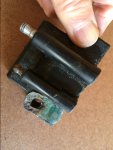The fuse in question is the main engine fuse. If it blows, the engine is dead, no spark, no starter. The factory fuse is smaller, a 20 amp Bombardier part number 510884. It is designed to fit in that red fuseholder. You should carry a few spares with you at all time. Should the fuse blow when you are out on the water-the engine is done. The black cylinder atop the airbox is the fuel primer solenoid. It is not the fuel pump. The red lever in the video is in the "service" position, not the "run" position. It will not run when you have it 90 degrees to the length of that solenoid. Turn it 90 degrees, so it is parallel to the length of the solenoid, as racerone stated. That's the "run" position. The round, black solenoid next to the starter is the starter solenoid. It converts the key switch energy into current to drive the starter. It has a set of heavy-duty contacts inside which are activated magnetically. You seem generally uniformed regarding the wiring on the engine. Suggest that you review the wiring diagram for your engine, found at the top thread of page 1 of this Johnson troubleshooting forum. Look in that thread titled: "top secret" files. Likely one of these wiring diagrams applies to your engine. The wiring diagram is in color and will be very helpful. You did not attempt to start the engine in the video. Does it crank but not start, or does it not crank at all? Two different scenarios-two different problem types. If you intend on working on your engine yourself, a factory service manual (not an aftermarket one) is useful. Check out this factory website for an original 1982 service manual: outboardbooks.com.




















